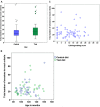Effect of Age and Dietary Intervention on Discrimination Learning in Pet Dogs
- PMID: 30487772
- PMCID: PMC6246696
- DOI: 10.3389/fpsyg.2018.02217
Effect of Age and Dietary Intervention on Discrimination Learning in Pet Dogs
Abstract
Aging is associated with a decline in cognitive functions such as learning, memory, attention, cognitive flexibility, and executive functions. Recent evidence indicates that interventions such as exercise, diet and cognitive training can be used to reduce the rate of age-dependent cognitive decline. In this study, we examined the changes in discrimination learning in older pet dogs, tested whether a dietary intervention counteracts a potential decline in learning and evaluated the influence of lifelong training on learning speed and cognitive flexibility. We included 115 pet dogs (>6 years) of 30 different breeds into one of two treatment groups: either a diet enriched with antioxidants, docosahexaenoic acid (DHA), Phosphatidylserine and tryptophan or a control diet for 1 year. Lifelong training was calculated for each dog using a questionnaire where owners filled their dog's training experiences over years. Dogs were trained to discriminate different pictures at the start of the dietary intervention using a touch screen methodology. After 1 year of dietary intervention, they were tested on a main picture discrimination task where they were confronted with a discrimination of four new pictures. We used the total number of sessions needed to reach learning criterion as a measure of learning speed and the rate of correction trials as a measure of deficit in learning from feedback/cognitive flexibility. In the main discrimination task, we found an influence of neither age nor diet on the speed of learning and deficit in learning from feedback. We did not find any influence of lifelong training either. The null findings were further corroborated by Bayesian statistics. The null findings might be due to the fact that pet dogs live in a stimulating environment which may reduce the rate of cognitive decline and hinder finding an age or diet effect. Also, the similarity between the training and the main discrimination task might have made the main task too easy for the animals to solve. Further studies are warranted to assess the effect of enriched diets on pet dogs using tasks that measure cognitive functions with a higher sensitivity.
Keywords: aging; dietary intervention; dog; learning; picture discrimination.
Figures




References
-
- Baddeley A. D., Baddeley H. A., Bucks R. S., Wilcock G. K. (2001). Attentional control in Alzheimer’s disease. Brain 124 1492–1508. - PubMed
LinkOut - more resources
Full Text Sources

